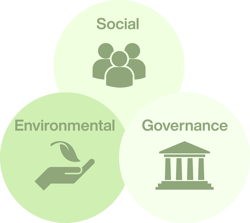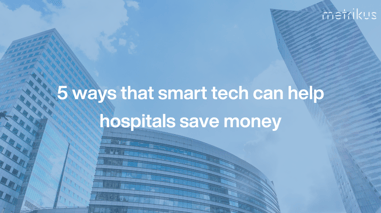How can IoT help your business with ESG reporting and performance?
ESG has grown massively in recent years, with the value of ESG-driven assets hitting a staggering $45 trillion in 2020.
However, despite the huge rise in ESG investing, there are still some issues when it comes to the collection of accurate ESG data. 53% of respondents to a BlackRock survey cited concerns about ‘poor quality or availability of ESG data and analytics’ as their biggest barrier to adopting sustainable investing.
There is an ever-growing need for investors to have better data on companies' non-financial performance. Luckily, IoT is on hand to provide a cost-effective solution to the collection of ESG data.
What is ESG and why is it important?
Before we get to the interesting stuff, it’s worth starting with the basics.
ESG stands for environmental, social and governance criteria, and it’s pivotal to the way today’s businesses operate. It’s all about a company’s business model, and how its products and services contribute to sustainable development.
- E: environmental criteria involves the impact a company has on the planet
- S: social criteria revolves around people and reputation
- G: governance criteria is all about how a company is managed
In recent years, ESG investing has extended beyond financial investments and into real estate. The appetite for tracking and prioritizing ESG factors in buildings has exploded, and there are several reasons why:
- The climate crisis and the risks associated with it have has driven investment in sustainable buildings
- Regulators working to address this problem are enacting stricter policies and standards
- Investors looking to make sound business decisions are increasingly looking for transparency and stakeholder engagement
It's clear that real estate is going to be one of the asset classes where the contrast between ESG winners and losers will be the starkest, as ESG is a measure of both impact and risk. 'Brown' assets and portfolios risk becoming obsolete, while 'green' assets will continue to increase in value.
Luckily, the outcome is not set in stone – technology can make it quick, easy and cost-effective for owners, managers and occupants to retrofit existing buildings and turn them into sustainable, efficient and healthy assets.
- To learn more about this ever-growing topic, check out The PropTech Guide to ESG.

What is IoT?
The Internet of Things (IoT) is the global network of physical assets – ‘things’, like sensors and devices – that are connected by the internet. These ‘things’ are used to monitor the world around them and to collect and exchange the resulting data.
Some ‘things’ collect and send information, some receive information and act upon it, and some can do both. What makes them smart is that they can talk to each other over the internet.
How can IoT help you with ESG monitoring and reporting?
There are two main reasons ESG and IoT go hand in hand.
Firstly, IoT can help to make the collection and reporting of ESG metrics way more accurate and streamlined. Secondly, there are loads of ways that IoT can actually help to enhance ESG performance.
Both are set for huge growth in the coming years, and it’s clear that there are going to be some exciting opportunities for the relationship between ESG and IoT to develop.
How can IoT help with ESG data collection?
ESG metrics can be measured and collated with precision with IoT sensors, including:
- Carbon footprint
- Energy efficiency
- Water quality and usage
- Waste management
- Indoor air quality
And importantly, a smart building platform like Metrikus brings all of this data into a single place so that performance can be traced with accuracy. It’s easy to see whether or not a company is hitting its targets, or if steps need to be taken to improve efficiency.
How can IoT enhance ESG performance?
As we’ve mentioned already, IoT not only allows key ESG metrics to be tracked, but can also help to enhance performance across key environmental, social and governance factors.
For example, using IoT sensors to monitor indoor air quality is an easily quantifiable way to optimise occupant health, wellbeing and productivity. Smart alerts can notify you when key air quality parameters deviate from their optimal zone, so that steps can be taken to maintain a healthy indoor environment.
Real-time occupancy monitoring can also help to improve ESG performance in a variety of ways:
- Reducing energy consumption by ensuring energy is only used when spaces are occupied
- Ensuring compliance with legal occupation requirements
- Enabling hotdesking and flexible work practices
- Facilitating social distancing by using smart alerts to avoid overcrowding
Companies can get secure and accurate data at their fingertips, documenting the improvements they’ve made and identifying any further opportunities for optimisation.
How can IoT help with sustainability?
Outside of the built environment, there a lots of other interesting ways that IoT can help with sustainability:
- AI-enabled traffic lights can adjust automatically to the volume of traffic, reducing the number of idling cars, a major source of greenhouse emissions
- IoT sensors can be used to monitor crops and soil to maximise crop production while maintaining a low impact on the environment
- Large forest areas can be monitored and protected using AI-enabled drones
- IoT sensors can monitor air pollution in real-time, enabling sources of pollution to be identified promptly and accurately
- Cameras or motion sensors can be used to monitor known poaching paths and reduce poaching activities significantly
- IoT technology can improve access to clean water by reducing leakages and monitoring water quality
If you’d like to find out more about this, check out our blog post with five interesting ways that IoT can help the environment.

ESG and IoT: why wait?
ESG issues are becoming an increasing priority across the world, and regulation is constantly encouraging us all to become more sustainable.
Going forwards, companies will be subjected to an increasing set of non-financial reporting requirements, including disclosing their ESG impact. Using IoT technology is a great way to get started with ESG, helping you to collect accurate data and improve your rating.
If you’d like to learn more and speak to an ESG expert, get in touch with us today.




